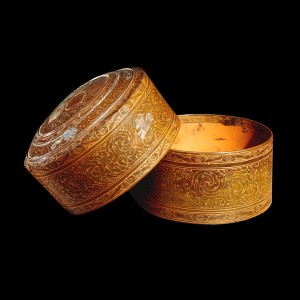
Lacquered Box, Han Dynasty (British Museum)
From Haizhou, Jiangsu province, southern China
Han dynasty (206 BC-AD 220)
An elegant toilet box
The earliest lacquered vessel discovered so far dates to around 7000 BC. Excavated objects from the Shang dynasty (about 1500-1050 BC) and the Zhou dynasty (1050-221 BC) demonstrate the increasingly sophisticated methods of production and decoration used on lacquer. By the time of the Han dynasty (206 BC-AD 220), the production of lacquer vessels was a centrally managed industry, with specialised labour and mass production in government-owned workshops.
The manufacture of lacquer pieces required several distinct, very labour-intensive, steps. First, a core was made, usually by hollowing out a piece of wood, occasionally made from fabric (as with this toilet box). It was then coated with many, very thin layers of lacquer, each taking several days to dry before the next could be applied. After the final layer was dry, the item passed to workmen who specialized in decorative painting or incising of patterns, the application of gilding or metal handles, and a final polishing.
This box is painted with cloud scrolls and inlaid with silver. Fantastic heavenly creatures are visible among the lines of the painted scrolls. A box similar to this one can be seen in use by court ladies in the famous scroll attributed to Gu Kaizhi, The Admonitions of the Instructress to the Court Ladies in The British Museum, the original of which dates to about AD 353.
J. Rawson (ed.), The British Museum book of Chi (London, The British Museum Press, 1992)
http://www.britishmuseum.org/explore/highlights/highlight_objects/asia/l/lacquered_box.aspx


Leave a Reply